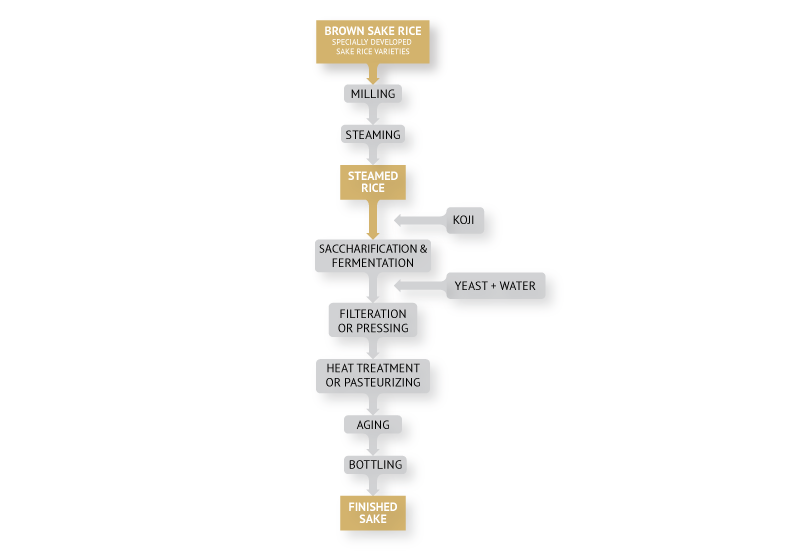
THE BREWING
Unlike grapes or honey, rice does not have fermentable sugars. Its starch has to be broken down into sugar. In this sense, the making of sake is closer to beer brewing. Beer uses malt that is germinated barley with the activity of starch breaking down enzymes, while sake uses the fungal enzymes of Koji. Yeast then proceeds to ferment the sugar to alcohol.
While beer goes through two separate production processes, mashing and fermentation, sake uses one process of simultaneous starch saccharification and yeast fermentation. This unique process gives sake an alcohol content of more than 18% by volume.
Because the sake brewing process occurs at low temperatures in open tanks, it takes 20-35 days to complete. A major concern is preventing contamination by unintended microorganisms. Brewing in cold weather minimizes the chances of contamination by airborne microbes. Heat treatment, like the Pasteurization of beer, is commonly used to prevent spoilage, and no preservatives are added in the brewing process. Fermented sake is then separated into liquid and residue by filtration, pressing or centrifugation.
Without separation, sake cannot be classified as genuine according to the Japanese sake tax code. Sake must be clear. Technically speaking, there is no such thing as unfiltered sake, often called Nigori. In the old days, sake was clouded with residue because of lack of technology or a method for separation. Racking produced clear sake for noble or wealthy people, while unclear sake was consumed by ordinary people.
Moonshine sake, often called “Doburoku”, was always turbid like bubbling rice gruel. In banning moonshine sake, the government at some point enforced separation of clear and residue portions. Doburoku, which looks similar to Nigori, is still illegal in Japan.
CLASSIFICATION
There are two basic classifications of sake: one is naturally fermented like wine or beer, another is alcohol added. The term “Junmai” is applied to naturally fermented sake, while no Junmai term on labels indicates that alcohol has been added. The terms of “Honjozzo” or “Daiginjo” without the “Junmai” term indicate the addition of grain alcohol which is allowed by the Japanese sake brewing code. Though some people complain that alcohol addition is not natural, it’s a traditional way of making certain types of sake.
Sake is brewed in the fall after the rice harvest. Many sake brewers keep to this traditional cycle, but some larger, more innovative sake brewers brew all season utilizing a cooling system. Sake from one season was typically sold and consumed until another brewing cycle started. Nowadays sake is purposely stored for aging.
PROCESS CHART

CHARACTER
Each naturally fermented alcoholic beverage has a characteristic appearance and flavor. Sake does not have any color or flavor derived from grape varieties, malt styles, or the addition of hops. Sake uses only starch located in the central portion of rice kernels. Removal of the outer layer of brown rice is important because it reduces foreign odor formation. It’s often said that the higher the polishing, the less foreign odor and the better the flavor. That might be true, but a major contributing factor is yeast. When aromatic yeast is used, the sake is aromatic. When acidic yeast is used, the sake is acidic. Yeast selection and fermentation conditions such as temperature, oxygen level, and tank dimension are key factors contributing to the flavor profile of the finished product.
Sake character is important in serving. The kind of sake chosen may depend on drinking styles (straight or mixed), seasons, daytime or night, indoor or outdoor, food pairing, and whether it’s to be served warmed or chilled.